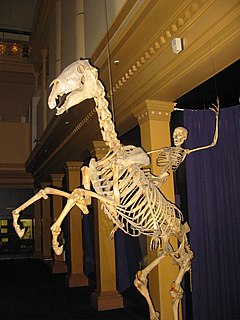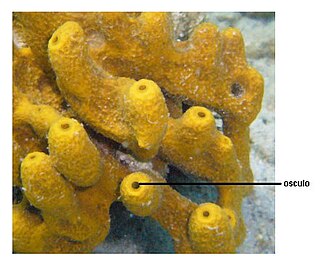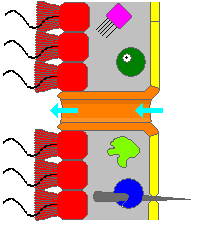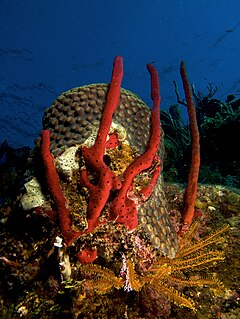
A skeleton is a structural frame that supports an animal body. There are several different skeletal types: the exoskeleton, which is the stable outer shell of an organism, the endoskeleton, which forms the support structure inside the body, and the hydroskeleton, a flexible skeleton supported by fluid pressure. The term comes from Greek σκελετός (skeletós) 'dried up'.

A flagellum is a hairlike appendage that protrudes from a wide range of microorganisms termed as flagellates. A flagellate can have one or several flagella. Certain other cells are flagellated, such as the mammalian sperm cell, which uses its flagellum to propel itself through the female reproductive tract. The primary function of a flagellum is that of motility. In some bacteria the flagellum can also function as a sensory organelle, being sensitive to wetness, chemicals, and temperatures outside the cell.

Sponges, the members of the phylum Porifera, are a basal animal clade as a sister of the Diploblasts. They are multicellular organisms that have bodies full of pores and channels allowing water to circulate through them, consisting of jelly-like mesohyl sandwiched between two thin layers of cells.

Hexactinellid sponges are sponges with a skeleton made of four- and/or six-pointed siliceous spicules, often referred to as glass sponges. They are usually classified along with other sponges in the phylum Porifera, but some researchers consider them sufficiently distinct to deserve their own phylum, Symplasma. Some experts believe glass sponges are the longest-lived animals on earth; these scientists tentatively estimate a maximum age of up to 15,000 years.

The Venus' flower basket is a glass sponge in the phylum Porifera. It is a marine sponge found in the deep waters of the Pacific ocean. As other glass sponges, they build their skeletons out of silica, which is of great interest in materials science as their optical and mechanical properties are in some ways superior to man-made materials. Like other sponges, they feed by filtering sea water to capture plankton.

The osculum is an excretory structure in the living sponge, a large opening to the outside through which the current of water exits after passing through the spongocoel. Wastes diffuse into the water and the water is pumped through the osculum carrying away with it the sponge's wastes. Sponges pump large volumes of water: typically a volume of water equal to the sponge's body size is pumped every five seconds. The size of the osculum is regulated by contractile myocytes. Its size, in turn, is one of the factors which determines the amount of water flowing through the sponge. It can be closed completely in response to excess silt in the water.

Choanocytes are cells that line the interior of asconoid, syconoid and leuconoid body types of sponges that contain a central flagellum, or cilium, surrounded by a collar of microvilli which are connected by a thin membrane.
Porocytes are tubular cells which make up the pores of a sponge known as ostia.

A contractile vacuole (CV) is a sub-cellular structure (organelle) involved in osmoregulation. It is found predominantly in amoeba and in unicellular algae. It was previously known as pulsatile or pulsating vacuole.

An undulipodium or a 9+2 organelle is a motile filamentous intracellular projection of eukaryotic cells. It is basically synonymous to flagella and cilia which are differing terms for similar molecular structures used on different types of cells, and usually correspond to different waveforms.

Anheteromeyenia argyrosperma is a freshwater sponge found across North America.

The Urmetazoan is the hypothetical last common ancestor of all animals or metazoans. It is universally accepted to be a multicellular heterotroph — with the novelties of a germline and oogamy, an extracellular matrix (ECM) and basement membrane, cell-cell and cell-ECM adhesions and signaling pathways, collagen IV and fibrillar collagen, different cell types, spatial regulation and a complex developmental plan, and relegated unicellular stages — but much more information about it is still unknown.

Xestospongia testudinaria is a species of barrel sponge in the family Petrosiidae. More commonly known as Giant Barrel Sponges, they have the basic structure of a typical sponge. Their body is made of a reticulation of cells aggregate on a siliceous scaffold composed of small spikes called spicules. Water is taken into the inner chamber of the sponge through ostia. Flagellated choanocytes line the inner chamber and help generate water currents through the sponge.
The choanoderm is a type of cell layer composed of flagellated collar cells, or choanocytes, found in sponges. The sponge body is mostly a connective tissue; the mesohyl, over which are applied epithelioid monolayers of cells, the outer pinacoderm and the inner choanoderm.

Amphimedon compressa, the erect rope sponge, red tree sponge, red tubular sponge, or red sponge is a demosponge found in southern Florida, the Caribbean Sea, and the Bahamas. It can be deep red, orange, brown, or black.

Spongiforma is a genus of sponge-like fungi in the family Boletaceae. Newly described in 2009, the genus contains two species: S. thailandica and S. squarepantsii. The type species S. thailandica is known only from Khao Yai National Park in central Thailand, where it grows in soil in old-growth forests dominated by dipterocarp trees. The rubbery fruit bodies, which has a strong odour of coal-tar similar to Tricholoma sulphureum, consists of numerous internal cavities lined with spore-producing tissue. S. squarepantsii, described as new to science in 2011, is found in Malaysia. It produces sponge-like, rubbery orange fruit bodies with a fruity or musky odour. These fruit bodies will—like a sponge—resume their original shape if water is squeezed out. The origin of the specific name derives from its perceived resemblance to the cartoon character SpongeBob SquarePants. Apart from differences in distribution, S. squarepantsii differs from S. thailandica in its colour, odour, and spore structure.
Homaxinella balfourensis is a species of sea sponge in the family Suberitidae. It is found in the seas around Antarctica and can grow in two forms, either branching out in one plane like a fan or forming an upright club-like structure.

Tectitethya crypta is a species of demosponge belonging to the family Tethyidae. Its classified family is characterized by fourteen different known genera, one of them being Tectitethya. It is a massive, shallow-water sponge found in the Caribbean Sea. This sponge was first discovered by Werner Bergmann in 1945 and later classified by de Laubenfels in 1949. It is located in reef areas situated on softer substrates such as sand or mud. Oftentimes, it is covered in sand and algae. This results in an appearance that is cream colored/ gray colored; however, when the animal is washed free of its sediment coverings, its body plan appears more green and gray. It's characterized with ostia peaking out of its body cavity, with the ability to abruptly open or close, changing its desired water flow rate through its mesohyl.
Agelas schmidti, commonly known as the brown tubular sponge, is a species of demosponge. It occurs at moderate depths in the Gulf of Mexico and the Caribbean Sea and often has a colonial coral growing over the surface. The type locality is Puerto Rico.
Neofibularia nolitangere, commonly known as the touch-me-not sponge, is a species of sea sponge in the family Biemnidae. It is found in shallow waters in the Western Atlantic Ocean and the Caribbean Sea.














